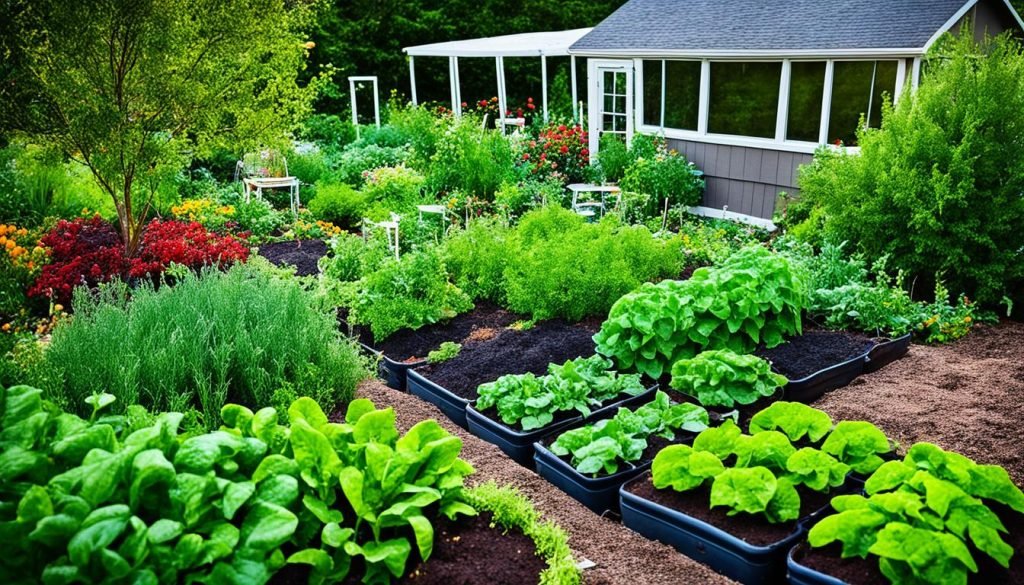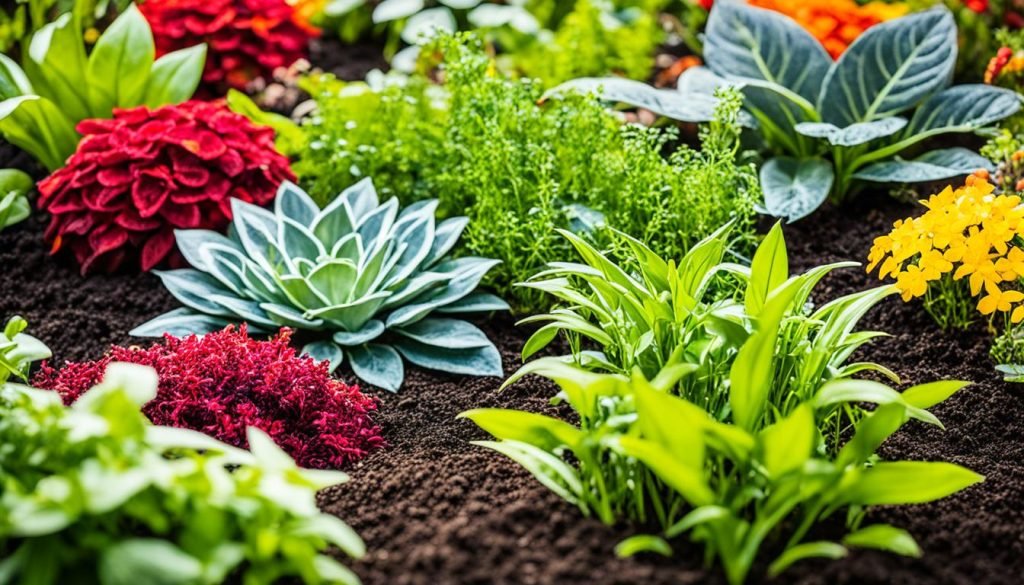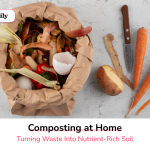Did you know that conventional agriculture uses over 5 billion pounds of pesticides annually? These chemicals have detrimental effects on human health and the environment. Organic gardening techniques, on the other hand, offer a sustainable and eco-friendly approach to growing your own food. By adopting natural gardening methods, you can create a chemical-free and earth-friendly garden that nourishes both you and the planet.

Key Takeaways:
- Organic gardening promotes sustainable and non-toxic gardening practices.
- By focusing on soil fertility, proper watering, and organic pest control, beginners can establish a successful organic garden.
- Choosing the right garden location and starting small with a few vegetables are crucial for organic gardening success.
- Building healthy soil with organic matter and starting with baby plants from a nursery contribute to the overall health of your garden.
- By finding your garden niche and focusing on specific crops, you can enjoy the process and maximize your gardening efforts.
Importance of Soil Fertility in Organic Gardening
Soil fertility is a fundamental aspect of successful organic gardening. In order for plants to thrive and produce healthy yields, they require a nutrient-rich growing medium. Additionally, optimal soil fertility provides plants with adequate water and oxygen, which are crucial for their growth.
One of the key elements in improving soil fertility is increasing the organic matter content. Organic matter serves as a source of nutrients and helps improve soil structure, moisture retention, and microbial activity. It acts as a reservoir for essential minerals and provides a favorable environment for beneficial soil organisms.
“Healthy, fertile soil provides essential nutrients, water, and oxygen to plants.”
There are several ways to enhance soil fertility in organic gardening. Animal manures, such as composted cow or chicken manure, are rich in organic matter and nutrients. They can be applied to the garden beds during the preparation or as a top dressing throughout the growing season. Compost, made from decomposed plant materials, is another valuable amendment that improves both soil structure and nutrient availability.
In addition to organic matter, cover crops and green manures play a vital role in building soil fertility. Cover crops, such as legumes, help fix nitrogen from the atmosphere and incorporate it into the soil. This process increases the availability of this essential nutrient for the subsequent crops. Green manures, which are cover crops specifically sown and then plowed under to decompose, add organic matter and valuable nutrients to the soil.
Benefits of Improving Soil Fertility in Organic Gardening
Improving soil fertility through the use of organic matter, compost, cover crops, and green manures offers several benefits for organic gardeners:
- Enhanced nutrient availability: Fertile soil provides a steady supply of essential nutrients for plants, reducing the likelihood of nutrient deficiencies.
- Improved water retention: Soil high in organic matter retains moisture better, reducing the need for frequent watering and helping plants withstand drought conditions.
- Promotion of beneficial soil microorganisms: Organic matter supports a diverse population of beneficial microorganisms, which contribute to nutrient cycling and disease suppression.
- Reduced reliance on synthetic inputs: Improving soil fertility naturally reduces the need for synthetic fertilizers and chemicals, aligning with the principles of organic gardening.
Fertilizing with Organic Matter and Nutrient Content
| Amendment | Nitrogen (N) | Phosphorus (P) | Potassium (K) |
|---|---|---|---|
| Composted Manure | 1-3% | 1-2% | 1-3% |
| Compost | 0.5-3% | 0.3-2% | 0.5-3% |
| Cover Crops | Variable | Variable | Variable |
| Green Manures | 1-5% | 0.5-3% | 1-3% |
In organic gardening, fostering soil fertility is a key element in sustainable and eco-friendly plant cultivation. By incorporating organic matter, compost, cover crops, and green manures, gardeners can create a resilient and nutrient-rich environment that supports healthy plant growth and bountiful harvests.
Choosing the Right Garden Location
The location of your garden is a critical factor in its success. Consider various aspects when deciding where to establish your organic garden. Take into account factors like sunlight, accessibility, shade, soil quality, wildlife control, chemical drift, and garden flooding.
Sunlight
Most vegetables thrive in full sun, requiring at least 8 hours of direct sunlight each day. It’s essential to choose a location that receives ample sunlight to promote healthy plant growth and maximize yields.
Accessibility
An easily accessible garden makes it convenient for you to tend to your plants and harvest produce. Select a location that is convenient to reach, avoiding areas that may be challenging to access or require extensive travel.
Shade
While sunlight is crucial, certain plants benefit from partial shade. If you plan to grow shade-tolerant plants, ensure there are nearby structures or trees that provide adequate shade during the hottest parts of the day.
Soil Quality
The quality of the soil directly impacts plant health and productivity. Conduct a soil test to assess its composition and fertility. Choose a garden location with good soil quality or be prepared to amend it accordingly with organic matter, compost, and other soil additives.
Wildlife Control
Consider potential challenges from wildlife in your chosen garden location. Determine if protective fencing or other measures are necessary to prevent damage from animals like rabbits, deer, or groundhogs.
Chemical Drift
Ensure that neighboring yards or agricultural areas do not have a history of chemical drift. Harmful residues from pesticides or herbicides can negatively impact the health of your organic garden. Select a location away from potential sources of chemical contamination.
Garden Flooding
Avoid garden locations prone to flooding, as excessive water can drown plants, disrupt root systems, and lead to disease. Pick a well-drained site or consider implementing drainage systems to prevent waterlogging.
Choosing the right garden location is crucial for successful organic gardening. Consider the sunlight, accessibility, shade, soil quality, wildlife control, chemical drift, and garden flooding when selecting the perfect spot for your organic garden. Now that you’ve found the ideal location, let’s explore how to start small and focus on a few vegetables in the next section.
Start Small and Focus on a Few Vegetables
When it comes to organic gardening, starting small and focusing on a few vegetables is the way to go. This approach allows beginners to learn and master specific crops before expanding their garden. By starting small, you can manage your garden more effectively and gradually increase its size as you gain confidence and experience.
One key aspect of starting small is to concentrate on vegetables that you enjoy eating. This not only makes gardening more rewarding but also ensures that you’re dedicating your time and effort to crops that you will fully enjoy. Take into consideration your personal vegetable preferences and select varieties that suit your climate, garden space, and flavor preferences.
Benefits of Starting Small:
“Starting small and focusing on specific crops allows beginners to learn and master essential organic gardening techniques without feeling overwhelmed.”
- Better manageability: Starting with a small garden allows you to easily keep track of your plants and provide the necessary care and attention they require.
- Increased success rate: By focusing on a few vegetables, you can dedicate your time and resources to mastering their specific needs, resulting in higher success rates.
- Learning opportunities: As a beginner, starting small provides valuable opportunities to learn about organic gardening techniques, soil management, pest control, and other essential aspects of growing vegetables.
- Build confidence: Successfully growing a few vegetables helps build confidence and provides a solid foundation for expanding your garden in the future.
Choosing the Right Vegetables:
When selecting vegetables for your small garden, consider the following factors:
- Climate suitability: Choose vegetables that are well-suited to your local climate. Check the plant hardiness zone and growing requirements of each vegetable before making your selection.
- Garden space: Evaluate the available space in your garden and choose vegetables that can comfortably grow within that area. Look for compact varieties or opt for vertical gardening techniques to maximize space.
- Flavor preferences: Give priority to vegetables that you and your family enjoy eating. Organic gardening becomes even more satisfying when you can harvest and consume your favorite vegetables.
Remember, starting small doesn’t mean compromising on the variety or diversity of your vegetable garden. Even with a limited number of vegetables, you can still enjoy a bountiful harvest and experience the joys of organic gardening.
| Common Vegetables to Start Small | Climate Suitability | Description |
|---|---|---|
| Tomatoes | Most climates | Easy to grow and versatile, with a wide range of varieties available. |
| Lettuce | Cool-season climates | Quick-growing leafy greens that thrive in cooler temperatures. |
| Green Beans | Warm-season climates | Productive and easy to grow, with both bush and pole varieties. |
| Zucchini | Warm-season climates | Fast-growing summer squash that can produce an abundance of fruit. |
| Bell Peppers | Warm-season climates | Colorful and flavorful peppers that thrive in warm temperatures. |
Ensuring Proper Watering in Your Garden
Water is a vital component for the healthy growth of plants in your garden. To ensure that your plants receive the right amount of water, it’s important to follow proper watering techniques and maintain a good moisture balance.
First and foremost, make sure that your garden is located near a water source. This will make it easier for you to access water for your plants whenever necessary. Having a convenient water source will save you time and effort in watering your garden.
When it comes to watering methods, there are several options to choose from. You can set up an irrigation system using sprinklers, soaker hoses, or drip irrigation. These systems help distribute water evenly and efficiently throughout your garden, ensuring that each plant receives an adequate amount of moisture.
To maintain a good moisture balance in the soil, it’s important to water your plants consistently. Keep the soil moist, but be careful not to overwater and saturate the soil. Overwatering can lead to root rot and other plant diseases. Be mindful of the specific water needs of different plants and adjust your watering schedule accordingly.
One effective technique in organic gardening is the use of row covers. Row covers act as a protective layer for your plants, shielding them from extreme temperatures and providing frost protection. They also help retain moisture by preventing evaporation, reducing the need for frequent watering.
“Proper watering is essential for maintaining healthy plants in your garden. By following organic gardening techniques, you can ensure that your plants receive the right amount of water to thrive.”
Summary of Watering Techniques:
- Locate your garden near a water source for easy access.
- Consider using an irrigation system for efficient watering.
- Maintain a good moisture balance by keeping the soil moist but not saturated.
- Use row covers to protect plants and reduce the need for frequent watering.
| Watering Method | Description | Advantages |
|---|---|---|
| Sprinklers | Water is distributed through sprinkler heads, simulating rainfall. | – Covers a large area – Provides consistent watering |
| Soaker Hoses | Hoses with small holes deliver water directly to the base of plants. | – Delivers water directly to roots – Reduces water wastage |
| Drip Irrigation | Water is delivered through a network of tubes and emitters directly to plants. | – Highly efficient water usage – Reduces weed growth |
Using Organic Pest Control Methods
When it comes to organic gardening techniques, pest control is an essential aspect. Rather than relying on synthetic chemicals, organic gardeners prefer natural methods to keep pests at bay. By adopting organic pest control methods, you can maintain a healthy and thriving garden without compromising the environment or your health.
To effectively control pests in your organic garden, it’s important to regularly inspect your plants for signs of pest infestations and diseases. Early detection allows you to take necessary measures and prevent further damage. Keep an eye out for chewed leaves, wilting plants, or unusual spots on foliage.
One of the most effective ways to control pests naturally is by attracting beneficial insects to your garden. These insects, such as ladybugs, lacewings, and parasitic wasps, feed on harmful pests like aphids, caterpillars, and mites. You can attract beneficial insects by planting flowering plants that provide them with nectar and shelter.
Companion planting is another organic pest control technique that involves cultivating plants that mutually benefit each other. For example, planting marigolds near your vegetable crops can deter pests such as nematodes and aphids. Similarly, interplanting aromatic herbs like basil and rosemary in your garden can repel unwanted insects.
Feeding your plants with organic plant food helps them grow strong and resistant to pests and diseases. Organic plant food contains natural ingredients that nourish the soil and provide essential nutrients to plants. By maintaining healthy and robust plants, you make them less susceptible to pest attacks.
“Organic pest control methods are vital for maintaining a balance between pests and beneficial insects in your garden. By avoiding synthetic chemicals and relying on natural techniques, you create a harmonious environment for your plants to thrive.”
While organic pest control methods should be your first line of defense, there may be situations where you need to resort to synthetic chemicals as a last resort. If you do use them, select target-specific options that are least harmful to beneficial insects and the environment.
| Pest Control Method | Description |
|---|---|
| Beneficial Insects | Attracting insects like ladybugs and lacewings that feed on harmful pests |
| Companion Planting | Planting specific plants that repel pests or attract beneficial insects |
| Organic Plant Food | Providing nutrition to plants and improving their resistance to pests and diseases |
| Synthetic Chemicals | Using target-specific options as a last resort |
Building Healthy Soil with Organic Matter
Healthy soil is the foundation of a successful organic garden. By enriching your soil with organic matter, you can ensure that your plants receive the nutrients they need to thrive. There are several organic gardening techniques you can use to build healthy soil:
- Compost: Compost is a key component of organic matter and can significantly improve soil fertility. Adding 2-6 inches of compost at the beginning of the gardening season and 1-2 inches every season thereafter can enhance the nutrient content and structure of the soil.
- Topsoil: Incorporating nutrient-rich topsoil into your garden beds can further enhance soil fertility. Look for high-quality topsoil that is free from synthetic fertilizers and chemicals.
- Chemical-Free Fertilizer: Instead of relying on chemical fertilizers, opt for organic and chemical-free alternatives. Organic fertilizers, such as compost tea or fish emulsion, provide nutrients to the soil in a natural and sustainable way.
Organic matter, such as compost and topsoil, improves soil structure and promotes beneficial microbial activity. It increases the soil’s ability to retain moisture, reduces erosion, and enhances root development.
Remember to purchase high-quality compost from a trusted source. Avoid synthetic fertilizers and chemicals, as they can harm the environment and disrupt the natural balance of your garden ecosystem.

Benefits of Organic Matter in the Soil
“Organic matter in the soil acts as a sponge, improving soil structure and water retention. It also provides a food source for beneficial soil organisms and promotes overall soil health.” – Dr. Emily Green, Soil Scientist
| Benefits of Organic Matter in the Soil | How it Helps |
|---|---|
| Improved Soil Fertility | Organic matter supplies essential nutrients to plants and promotes microbial activity, allowing for better nutrient uptake. |
| Enhanced Moisture Retention | Organic matter improves the soil’s water-holding capacity, reducing the need for frequent watering. |
| Reduced Soil Erosion | The structure provided by organic matter helps prevent soil erosion caused by wind and water. |
| Promotion of Beneficial Soil Organisms | Organic matter supports a diverse community of beneficial soil organisms, such as earthworms and microorganisms, which help break down organic matter and improve nutrient availability. |
| Improved Root Development | The presence of organic matter creates a loose and friable soil texture, allowing roots to penetrate easily and access nutrients. |
Starting with Baby Plants from a Nursery
For beginners in organic gardening, starting with healthy seedlings from a local organic nursery is highly recommended. When compared to starting from seeds, it can be a simpler and more convenient option. Seed starting requires additional equipment, knowledge, and attention to detail. By opting for baby plants or transplants, you can skip the initial stages of germination and early growth, allowing you to focus on nurturing and developing the vegetables.
One of the key advantages of getting baby plants from a nursery is ensuring that they haven’t been treated with harmful chemicals. It’s important to select organically grown seedlings to align with the principles of organic gardening. Organic nurseries prioritize growing plants using natural methods, free from synthetic pesticides and fertilizers.
Consulting with knowledgeable nursery staff is beneficial, especially if you’re new to organic gardening. They can guide you in selecting the best vegetable varieties that are suitable for your garden’s climate, soil conditions, and available sunlight. Their expertise can prove invaluable in helping you make informed decisions and setting a strong foundation for your organic garden.
Tips for selecting baby plants from a nursery:
- Choose plants that have a healthy appearance, with vibrant green leaves and sturdy stems.
- Avoid plants with signs of stress or damage, such as wilting, yellowing leaves, or pests.
- Check the roots of the seedlings to ensure they are well-developed and not root-bound.
- Consider the maturity of the plants, selecting ones that are not overly mature or leggy.
Benefits of starting with baby plants:
Starting with baby plants from a nursery saves time and effort, providing a head start in the organic gardening journey. It allows beginners to bypass the more challenging aspects of seed starting and focus on nurturing the young plants. Additionally, by selecting organically grown seedlings, gardeners can ensure that their garden remains free from synthetic chemicals, aligning with the principles of organic gardening.
| Advantages of Starting with Baby Plants from a Nursery | Disadvantages of Starting with Baby Plants from a Nursery |
|---|---|
|
|
Focus on Your Garden Niche
When it comes to organic gardening techniques, finding your garden niche can be a game-changer. By focusing on a specific niche, you can avoid feeling overwhelmed and maximize your chances of success. Here are some tips on how to narrow down your gardening focus:
- Choose plants that align with your interests and preferences: Select a few types of plants that you enjoy growing and consuming. Whether it’s vibrant tomatoes, fragrant herbs, or colorful flowers, find what sparks joy for you in the garden. This way, gardening becomes a fulfilling and enjoyable experience.
- Concentrate on becoming skilled in growing specific crops: Instead of trying to grow everything at once, start by mastering the cultivation of a few selected plants. Learn about their individual needs, such as proper planting depth, sunlight requirements, and watering preferences. This focused approach allows you to develop expertise and gain confidence in your gardening abilities.
- Consider niche gardening based on crop type or seasonality: Another way to narrow down your focus is by specializing in a specific crop type or growing season. For example, you could become an expert in growing heirloom tomatoes or focus on cultivating cool-season vegetables for a bountiful fall harvest. This specialization can help you refine your skills and achieve exceptional results.
Remember, your garden is a reflection of your unique interests and preferences. By finding your niche, you can create a personalized and rewarding gardening experience.
Illustration: Garden Niche Ideas
To inspire you in finding your garden niche, here are a few ideas:
| Garden Niche | Description |
|---|---|
| Herb Enthusiast’s Paradise | An abundant collection of culinary and medicinal herbs, carefully curated for various recipes and natural remedies. |
| Vertical Veggie Haven | A compact garden brimming with vertical growing structures, perfect for maximizing space and cultivating an array of vegetables. |
| Native Plant Sanctuary | A haven for local wildlife, featuring native plants that provide food and habitat while supporting ecological balance. |
| Four-Season Harvest | An all-year-round garden designed for continuous harvest by strategically selecting crops suitable for different seasons. |
These are just a few examples, and the possibilities are endless. Embrace your creativity and tailor your garden to your unique interests and goals.
Remember, finding your garden niche allows you to cultivate a deeper connection with your plants and create a space that brings you joy and satisfaction. So go ahead, explore different possibilities, and enjoy the journey of organic gardening.
Conclusion
Organic gardening offers a rewarding and sustainable approach to cultivating your own food. Whether you’re a beginner or an experienced gardener, incorporating these organic gardening techniques will help you establish a successful garden. Key factors such as building healthy soil, proper watering, effective pest control, and focusing on a few crops are crucial for a thriving and enjoyable organic garden.
Building healthy soil is the foundation for successful organic gardening. By adding organic matter like compost and topsoil, you can enhance soil fertility and provide essential nutrients to your plants. Remember to avoid synthetic fertilizers and chemicals, opting instead for organic alternatives.
Proper watering is vital for your plants’ growth and health. Ensure that your garden is located near a water source and set up an efficient irrigation system. Maintain a balanced moisture level in the soil, avoiding overwatering or allowing it to dry out completely. Consider using row covers to protect your plants and provide frost protection.
Organic pest control methods are preferred in organic gardening. Regularly inspect your plants for pests and diseases, and take action at the first sign of trouble. Encourage beneficial insects and birds to your garden by providing a diverse habitat. Use organic plant food to provide nutrition to your plants and soil, and only resort to synthetic chemical options as a last resort.
By applying these organic gardening techniques, beginners can confidently embark on their organic gardening journey. Enjoy the rewards of growing your own food while promoting a sustainable and healthy lifestyle. Happy gardening!


